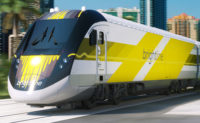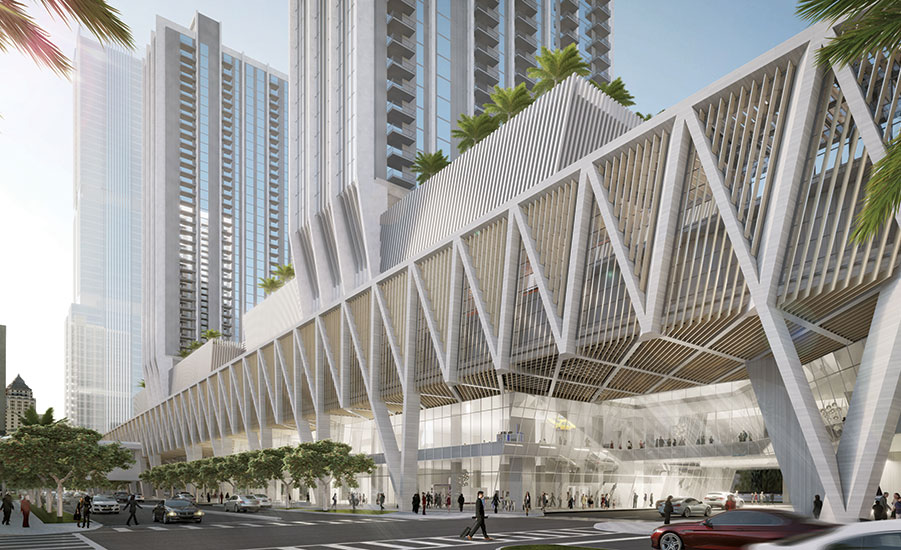ENR Southeast's 2016 Owner of the Year: Brightline
All Aboard Florida's Self-Propelled Paradigm Shift

Full Steam Ahead All Aboard Florida plans to start its Brightline service in 2017. Siemens is manufacturing the line’s trains in California. Images courtesy of All Aboard Florida

Signature Station All Aboard Florida’s $200-million Miami Central station will be the line’s flagship hub. In early March, crews placed more than 5,500 cu yd of concrete for the building’s foundation. Images courtesy of All Aboard Florida

Station Development Moss & Associates is leading design-build construction of the Brightline transit station in Fort Lauderdale. Images courtesy of All Aboard Florida

Veteran Leadership Michael Reininger, All Aboard Florida president, previously helped lead the redevelopment of Denver’s Union Station into a transit center. Images courtesy of All Aboard Florida




“Transformative” is the word that is often used to describe Brightline, the privately funded passenger rail system being built by All Aboard Florida. In many respects, it’s a fitting description, and one of the main reasons for the Coral Gables-based company’s selection as ENR Southeast’s Owner of the Year.
The approximately $3-billion rail project is entirely a private-sector effort—the only such transit program currently underway in the U.S.—and aspires to counter South Florida’s long-standing car-centric notion of mobility with modern, brightly colored trains providing fast, amenity-filled service between Miami, Fort Lauderdale and West Palm Beach, and eventually extending to Orlando and, perhaps, beyond.
In addition, All Aboard Florida is constructing stations designed by Skidmore, Owings and Merrill (SOM) and Miami’s Zyscovich Architects to provide a seamless transition of the rail service to its urban surroundings. The project’s total economic impact on the state over the next eight years, the company claims, could be as much as $6.4 billion.
“They’re definitely doing it right,” observes Andy Kunz, president and CEO of the Washington, D.C.-based U.S. High Speed Rail Association, adding that unlike the public sector, which treats transit as a basic service, All Aboard Florida is approaching the entire project as a business.
“Building their own stations will also help put people on the trains and cause a ripple effect of surrounding development,” he says.
That effect is already being felt, even though Brightline is still a year away from carrying its first passenger.
Kelly Smallridge, president and CEO of the Business Development Board of Palm Beach County, credits the under-construction 60,000-sq-ft West Palm Beach station for spurring roughly $2 billion of additional office, residential, hospitality and mixed-use projects in the community’s permit pipeline—a level of activity unseen since the 1990s.
“We’re talking about a completely different city than what we’re sitting in today,” she says.
This makeover reflects a shift in thinking about transportation, says Michael Reininger, All Aboard Florida’s president.
Though part of Florida East Coast Industries, a descendent of Henry Flagler’s namesake railroad, All Aboard Florida is characterized by Reininger as “a hospitality company in the railroad business,” a depiction that no doubt reflects his previous stints with subsidiaries of the Walt Disney Co. and leadership of the redevelopment of Denver’s Union Station into a model transit-oriented urban center.
Reininger adds that the timing is also right for a transportation alternative such as Brightline. He cites statistics showing that Florida’s increasingly diverse economy is among the fastest-growing in the U.S., fueled in part by businesses that are attractive to so-called “millennials,” whose preference for urban living makes car ownership less important.
And for those who still need their own set of wheels, Reininger asks, “What fun is having a car if you’re always stuck in traffic on a road network that was laid down in the 1960s?”
To be sure, All Aboard Florida began with more than just an idea for a transportation alternative. Reininger calls it “a gift” to have had a ready-made, well-maintained rail infrastructure linking the urban areas that are part of Brightline, which is being mostly built around existing infrastructure. To ensure those rails move people as safely and efficiently as they move freight, Archer Western is working on a $153.9-million rail infrastructure contract covering Brightline’s 66.5-mile-long Miami to West Palm segment. That project includes test tracks for the five-coach train sets currently being readied by Siemens in California.
As a private entity business, All Aboard Florida also possesses financial resources that most public-sector transit systems can only dream of, enabling All Aboard Florida to start station construction almost as soon as the designs were ready. Suffolk Construction is building the $200-million MiamiCentral station, part of a nine-acre, multimodal complex, while Moss & Associates is general contractor for the smaller Fort Lauderdale and West Palm Beach stations.
Reininger says having consultants and contractors that share All Aboard Florida’s “entrepreneurial and innovative mind-set” is critical to the project’s success. One of those contractors is Bob Moss, chairman of Moss & Associates, who counters that All Aboard Florida’s biggest advantage may well be Reininger himself.
“You couldn’t have a better leader for one of the most high-profile projects in Florida than him,” says Moss, who has more than two decades of experience working with the All Aboard Florida leader. “He’s also surrounded himself with other talented people who are skilled in getting big, complicated projects done.”
In the case of Brightline, getting things done has demanded the nimbleness to shift gears when things don’t unfold as planned.
While the initial Miami to West Palm Beach segment is funded using company equity, the original plan to finance the 168.5-mile extension to Orlando International Airport with a $1.5-billion federal Railroad Rehabilitation and Improvement Financing Loan was roundly criticized by project opponents in 2014 who claimed that the public would be on the hook for a potentially risky enterprise.
Despite reassurances that no public money would be involved with repaying the loan, All Aboard Florida opted instead to sell $1.75 billion in tax-exempt bonds—just as the capital markets began a downward spiral.
Two extensions from the U.S. Dept. of Transportation have given the company extra time to complete the sale. But with no immediate market improvement in sight, the Orlando extension is on a more fluid time line.
“We’re pressing pause until market conditions improve,” Reininger says, declining to say how long that might be, but noting that the extension’s final environmental impact statement has already been issued. “We don’t want to be under pressure to sell the bonds and wind up with less attractive financing that compromises the service we want to deliver.”
Last July, All Aboard Florida also hired Archer Western to manage construction for the rail infrastructure at Orlando International Airport, Brightline’s other terminus point, where the contractor will work with the Greater Orlando Aviation Authority to build the railway, roadway and related structures.
Fundraising has apparently not been a problem for opponents of the northern section. The governments of Martin and Indian River counties have allocated $6.6 million toward lawsuits aimed at blocking Brightline, which the suits claim will adversely impact property values and quality of life.
Reininger says that the concerns stem from “misinformation and misinterpretation” of the program from “a very minor but vocal group of people who have chosen to put roadblocks in the process.” All Aboard Florida has repeatedly offered to address community concerns through measures such as constructing tracks to higher safety standards and eliminating the need for trains to sound their horns, he says.
As a counter to the critics, Reininger points to several communities along Florida’s Space Coast that have expressed interest in becoming a part of a Brightline route.
“They see the advantages and opportunities, and want to get ahead of the curve,” he says, adding that discussions are underway regarding potential locations for new stations. While there’s no time line for those decisions, they are sure to be made using the same exhaustive research that All Aboard Florida invested in its three start-up stations.
“They’re thinking about big-picture things, such as locating the stations in places that make the most sense for passenger access,” observes T.J. Gottesdiener, SOM’s managing partner for the Brightline stations. “They’re looking 50 years into the future and thinking about what they’d like the district to be, and how the rail system will be a part of it.”
At the MiamiCentral station, for example, Brightline trains will utilize a 50-ft-high elevated platform, preserving existing street-level connections and activity. Inside, 200,000 sq ft of retail and food and beverage space will link concourses serving the city’s other transit services, while outdoor plazas and open space can be programmed for a variety of activities.
“Like the classic rail stations, Miami Central will weave a mix of uses into the city, but without interrupting the street grid,” Gottesdiener says. “You can move around the station, and into it.”
Many factors could crimp All Aboard Florida’s ambitious aspirations, from continued cheap gas prices that typically drain riders from other transit systems, to an economic downturn that might slow development around the stations.
Yet with the investment already made in facilities, infrastructure and start-up operations, All Aboard Florida is building up a figurative head of steam for next year’s debut. And there’s already talk about potential extensions of Brightline service once the Orlando segment is ready, with Tampa and Jacksonville frequently mentioned as potential destinations.
Those are issues for another day, insists Reininger, as All Aboard Florida is focused solely on getting its trains and stations ready to roll on schedule.
“When that’s complete, we’ll do what any business would do and look for ways to expand and capture more customers,” he says. “If something looks financially viable, we’ll formulate a way to do it.”







